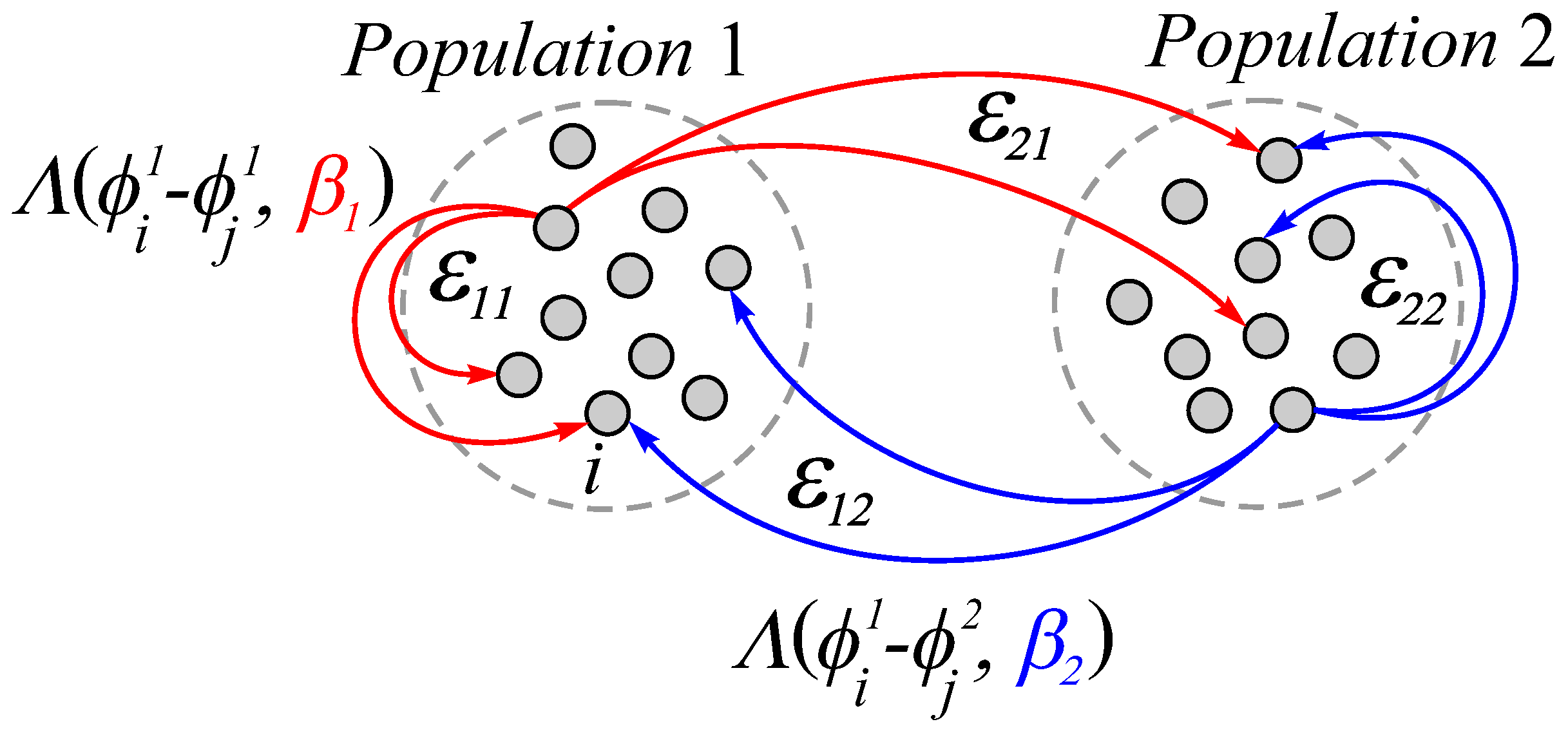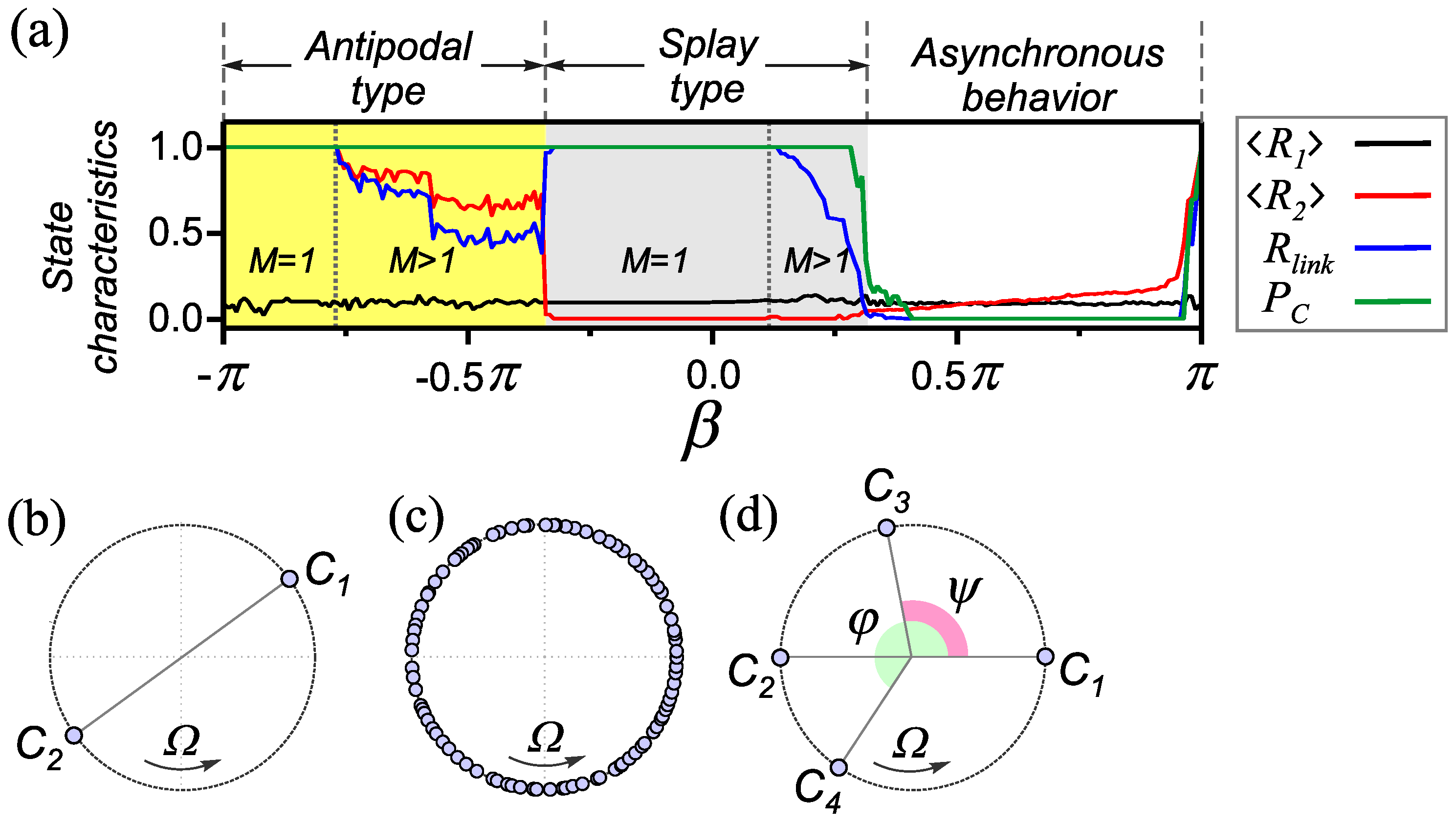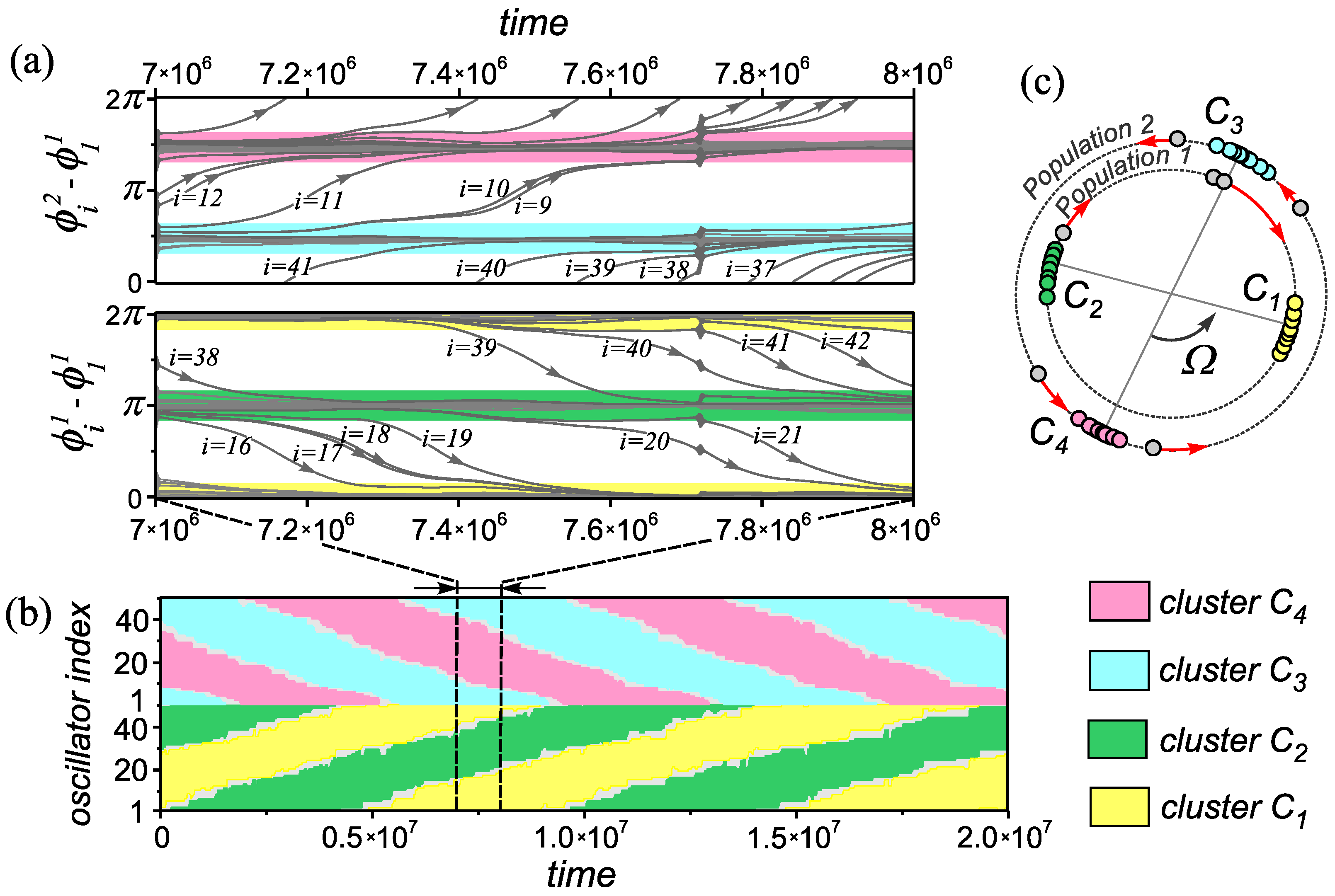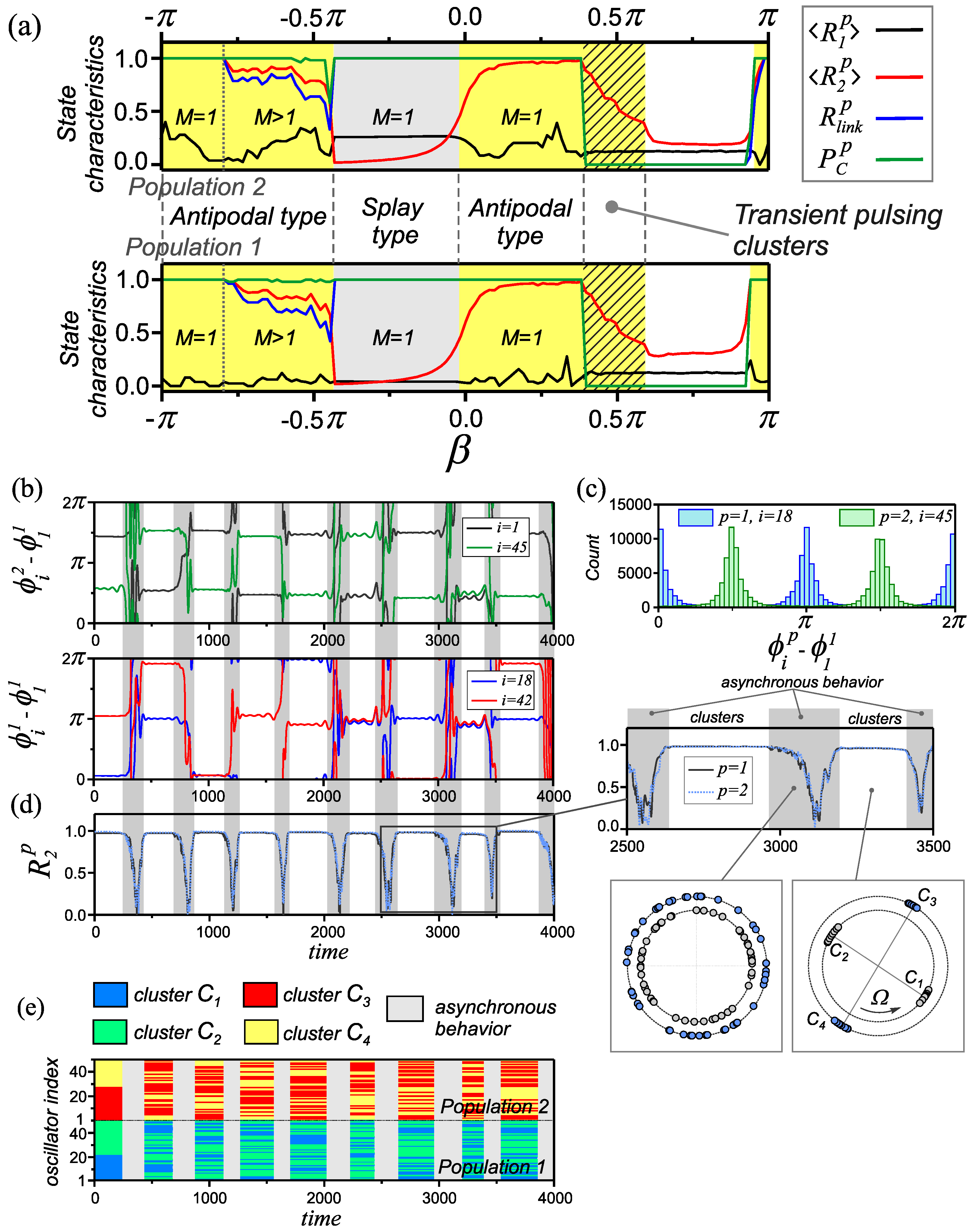Transient Phase Clusters in a Two-Population Network of Kuramoto Oscillators with Heterogeneous Adaptive Interaction
Abstract
1. Introduction
2. Model and Methods
2.1. The Model of an Adaptive Oscillatory Network
2.2. Basic Dynamic States in a Homogeneous Adaptive Network and Methods for Their Identification
3. Results
3.1. Effects in a Network with Heterogeneity according to the Rule of Coupling Adaptation
3.1.1. Combination of Adaptation Rules Supporting Splay States
3.1.2. Combination of Adaptation Rules Supporting States of Antipodal Type
3.1.3. Combination of Adaptation Rules Supporting States of Antipodal and Splay Types
3.2. Effects Observed in a Network with Heterogeneity in the Rate of Coupling Adaptation
3.2.1. Changing the Type of Synchronous States
3.2.2. Transient Pulsating Clusters
3.3. Effects Observed in the Network with the Combined Organization of Heterogeneity according to the Rules and the Rate of Coupling Adaptation
4. Discussion
Author Contributions
Funding
Institutional Review Board Statement
Data Availability Statement
Conflicts of Interest
References
- Newman, M.E.J. The Structure and function of complex networks. SIAM Rev. 2003, 45, 167–256. [Google Scholar] [CrossRef]
- Boccaletti, S.; Latora, V.; Moreno, Y.; Chavez, M.; Hwang, D.-U. Complex networks: Structure and dynamics. Phys. Rep. 2006, 424, 175–308. [Google Scholar] [CrossRef]
- Newman, M.; Barabasi, A.-L.; Watts, D.J. The Structure and Dynamics of Networks; Princeton University Press: Princeton, NJ, USA, 2008. [Google Scholar]
- Maslennikov, O.V.; Nekorkin, V.I. Adaptive dynamic networks. Phys.-Usp. 2017, 187, 745–756. [Google Scholar]
- Berner, R.; Gross, T.; Kuehn, C.; Kurths, J.; Yanchuk, S. Adaptive dynamical networks. Phys. Rep. 2023; submitted. [Google Scholar]
- Gross, T.; Blasius, B. Adaptive coevolutionary networks: A review. J. R. Soc. Interface 2008, 5, 259–271. [Google Scholar] [CrossRef] [PubMed]
- Sayama, H.; Pestov, I.; Schmidt, J.; Bush, B.J.; Wong, C.; Yamanoi, J.; Gross, T. Modeling complex systems with adaptive networks. Comput. Math. Appl. 2013, 65, 1645–1664. [Google Scholar] [CrossRef]
- Kuramoto, Y. Self-entrainment of a population of coupled non-linear oscillators. In International Symposium on Mathematical Problems in Theoretical Physics; Araki, H., Ed.; Springer: Berlin/Heidelberg, Germany, 1975; pp. 420–422. [Google Scholar]
- Kuramoto, Y. Chemical Oscillations, Waves, and Turbulence; Springer: Berlin/Heidelberg, Germany, 1984. [Google Scholar]
- Acebrón, J.A.; Bonilla, L.L.; Vicente, C.J.P.; Ritort, F.; Spigler, R. The Kuramoto model: A simple paradigm for synchronization phenomena. Rev. Mod. Phys. 2005, 77, 137. [Google Scholar] [CrossRef]
- Pikovsky, A.; Rosenblum, M. Dynamics of globally coupled oscillators: Progress and perspectives. Chaos 2015, 25, 097616. [Google Scholar] [CrossRef]
- Rodrigues, F.A.; Peron, T.K.D.; Ji, P.; Kurths, J. The Kuramoto model in complex networks. Phys. Rep. 2016, 610, 1. [Google Scholar] [CrossRef]
- Maistrenko, Y.L.; Lysyansky, B.; Hauptmann, C.; Burylko, O.; Tass, P.A. Multistability in the Kuramoto model with synaptic plasticity. Phys. Rev. E 2007, 75, 066207. [Google Scholar] [CrossRef]
- Ren, Q.; Zhao, J. Adaptive coupling and enhanced synchronization in coupled phase oscillators. Phys. Rev. E 2007, 76, 016207. [Google Scholar] [CrossRef] [PubMed]
- Niyogi, R.K.; English, L.Q. Learning-rate-dependent clustering and self-development in a network of coupled phase oscillators. Phys. Rev. E 2009, 80, 066213. [Google Scholar] [CrossRef] [PubMed]
- Picallo, C.B.; Riecke, I. Adaptive oscillator networks with conserved overall coupling: Sequential firing and near-synchronized states. Phys. Rev. E 2011, 83, 036206. [Google Scholar] [CrossRef] [PubMed]
- Gutiérrez, R.; Amann, A.; Assenza, S.; Gómez-Gardeñes, J.; Latora, V.; Boccaletti, S. Emerging meso- and macroscales from synchronization of adaptive networks. Phys. Rev. Lett. 2011, 107, 234103. [Google Scholar] [CrossRef]
- Assenza, S.; Gutiérrez, R.; Gómez-Gardeñes, J.; Latora, V.; Boccaletti, S. Emergence of structural patterns out of synchronization in networks with competitive interactions. Sci. Rep. 2011, 1, 99. [Google Scholar] [CrossRef]
- Avalos-Gaytán, V.; Almendral, J.A.; Papo, D.; Schaeffer, S.E.; Boccaletti, S. Assortative and modular networks are shaped by adaptive synchronization processes. Phys. Rev. E 2012, 86, 015101(R). [Google Scholar] [CrossRef]
- Aoki, T.; Aoyagi, T. Self-organized network of phase oscillators coupled by activity-dependent interactions. Phys. Rev. E 2011, 84, 066109. [Google Scholar] [CrossRef]
- Ren, Q.; He, M.; Yu, X.; Long, Q.; Zhao, J. The adaptive coupling scheme and the heterogeneity in intrinsic frequency and degree distributions of the complex networks. Phys. Lett. A 2014, 378, 3739–3744. [Google Scholar] [CrossRef]
- Kasatkin, D.V.; Yanchuk, S.; Schöll, E.; Nekorkin, V.I. Self-organized emergence of multilayer structure and chimera states in dynamical networks with adaptive couplings. Phys. Rev. E 2017, 96, 062211. [Google Scholar] [CrossRef]
- Berner, R.; Fialkowski, J.; Kasatkin, D.V.; Nekorkin, V.I.; Yanchuk, S.; Schöll, E. Hierarchical frequency clusters in adaptive networks of phase oscillators. Chaos 2019, 29, 103134. [Google Scholar] [CrossRef]
- Maslennikov, O.V.; Nekorkin, V.I. Hierarchical transitions in multiplex adaptive networks of oscillatory units. Chaos 2018, 28, 121101. [Google Scholar] [CrossRef] [PubMed]
- Kasatkin, D.V.; Nekorkin, V.I. The effect of topology on organization of synchronous behavior in dynamical networks with adaptive couplings. Eur. Phys. J.-Spec. Top. 2018, 227, 1051–1061. [Google Scholar] [CrossRef]
- Berner, R.; Schöll, E.; Yanchuk, S. Multiclusters in networks of adaptively coupled phase oscillators. SIAM J. Appl. Dyn. Syst. 2019, 18, 2227–2266. [Google Scholar] [CrossRef]
- Berner, R.; Polanska, A.; Schöll, E.; Yanchuk, S. Solitary states in adaptive nonlocal oscillator networks. Eur. Phys. J. Spec. Top. 2020, 229, 2183–2203. [Google Scholar] [CrossRef]
- Emelianova, A.A.; Nekorkin, V.I. On the intersection of a chaotic attractor and a chaotic repeller in the system of two adaptively coupled phase oscillators. Chaos 2019, 29, 111102. [Google Scholar] [CrossRef]
- Emelianova, A.A.; Nekorkin, V.I. The third type of chaos in a system of two adaptively coupled phase oscillators. Chaos 2020, 30, 051105. [Google Scholar] [CrossRef]
- Emelianova, A.A.; Nekorkin, V.I. Emergence and synchronization of a reversible core in a system of forced adaptively coupled Kuramoto oscillators. Chaos 2021, 31, 033102. [Google Scholar] [CrossRef]
- Castro-Alamancos, M.A.; Donoghue, J.P.; Connors, B.W. Different forms of synaptic plasticity in somatosensory and motor areas of the neocortex. J. Neurosci. 1995, 15, 5324–5333. [Google Scholar] [CrossRef]
- Citri, A.; Malenka, R.C. Synaptic plasticity: Multiple forms, functions, and mechanisms. Neuropsychopharmacology 2008, 33, 18–41. [Google Scholar] [CrossRef]
- Edelmann, E.; Cepeda-Prado, E.; Leßmann, V. Coexistence of multiple types of synaptic plasticity in individual hippocampal CA1 pyramidal neurons. Front. Synaptic Neurosci. 2017, 9, 7. [Google Scholar] [CrossRef]
- Magee, J.C.; Grienberger, C. Synaptic plasticity forms and functions. Annu. Rev. Neurosci. 2020, 43, 95–117. [Google Scholar] [CrossRef] [PubMed]
- Kasatkin, D.V.; Nekorkin, V.I. Transient circulant clusters in two-population network of Kuramoto oscillators with different rules of coupling adaptation. Chaos 2021, 31, 073112. [Google Scholar] [CrossRef] [PubMed]
- Thiele, M.; Berner, R.; Tass, P.A.; Schöll, E.; Yanchuk, S. Asymmetric adaptivity induces recurrent synchronization in complex networks. Chaos 2023, 33, 023123. [Google Scholar] [CrossRef]
- Berner, R.; Yanchuk, S. Synchronization in networks with heterogeneous adaptation rules and applications to distance-dependent synaptic plasticity. Front. Appl. Math. Stat. 2021, 7, 714978. [Google Scholar] [CrossRef]
- Kasatkin, D.V.; Nekorkin, V.I. Dynamics of the oscillators with plastic couplings. Radiophys. Quantum Electron. 2016, 58, 877–891. [Google Scholar] [CrossRef]
- Markram, H.; Lübke, J.; Frotscher, M.; Sakmann, B. Regulation of synaptic efficacy by coincidence of postsynaptic APs and EPSPs. Science 1997, 275, 213–215. [Google Scholar] [CrossRef]
- Caporale, N.; Dan, Y. Spike timing-dependent plasticity: A Hebbian learning rule. Annu. Rev. Neurosci. 2008, 31, 25–46. [Google Scholar] [CrossRef]
- Hebb, D.O. The Organization of Behavior; Wiley: New York, NY, USA, 1949. [Google Scholar]
- Freeman, W.J. Evidence from human scalp electroencephalograms of global chaotic itinerancy. Chaos 2003, 13, 1067–1077. [Google Scholar] [CrossRef]
- Goldberg, J.A.; Rokni, U.; Sompolinsky, H. Patterns of ongoing activity and the functional architecture of the primary visual cortex. Neuron 2004, 42, 489–500. [Google Scholar] [CrossRef]
- Mason, M.F.; Norton, M.I.; Van Horn, J.D.; Wegner, D.M.; Grafton, S.T.; Macrae, C.N. Wandering minds: The default network and stimulus-independent thought. Science 2007, 315, 393–395. [Google Scholar] [CrossRef]







| Network State | ||||
|---|---|---|---|---|
| Global network synchronization | 1 | 1 | 1 | 1 |
| One synchronous group (antipodal type) | ∼0 | 1 | 1 | 1 |
| One synchronous group (splay type) | ∼0 | ∼0 | 1 | 1 |
| M synchronous group with different frequency (antipodal type) | ∼0 | 1 | ||
| M synchronous group with different frequency (splay type) | ∼0 | ∼0 | 1 | |
| Chimera state | ∼0 | 1 | ||
| Asynchronous behavior | 0 | 0 | 0 | 0 |
Disclaimer/Publisher’s Note: The statements, opinions and data contained in all publications are solely those of the individual author(s) and contributor(s) and not of MDPI and/or the editor(s). MDPI and/or the editor(s) disclaim responsibility for any injury to people or property resulting from any ideas, methods, instructions or products referred to in the content. |
© 2023 by the authors. Licensee MDPI, Basel, Switzerland. This article is an open access article distributed under the terms and conditions of the Creative Commons Attribution (CC BY) license (https://creativecommons.org/licenses/by/4.0/).
Share and Cite
Kasatkin, D.V.; Nekorkin, V.I. Transient Phase Clusters in a Two-Population Network of Kuramoto Oscillators with Heterogeneous Adaptive Interaction. Entropy 2023, 25, 913. https://doi.org/10.3390/e25060913
Kasatkin DV, Nekorkin VI. Transient Phase Clusters in a Two-Population Network of Kuramoto Oscillators with Heterogeneous Adaptive Interaction. Entropy. 2023; 25(6):913. https://doi.org/10.3390/e25060913
Chicago/Turabian StyleKasatkin, Dmitry V., and Vladimir I. Nekorkin. 2023. "Transient Phase Clusters in a Two-Population Network of Kuramoto Oscillators with Heterogeneous Adaptive Interaction" Entropy 25, no. 6: 913. https://doi.org/10.3390/e25060913
APA StyleKasatkin, D. V., & Nekorkin, V. I. (2023). Transient Phase Clusters in a Two-Population Network of Kuramoto Oscillators with Heterogeneous Adaptive Interaction. Entropy, 25(6), 913. https://doi.org/10.3390/e25060913






